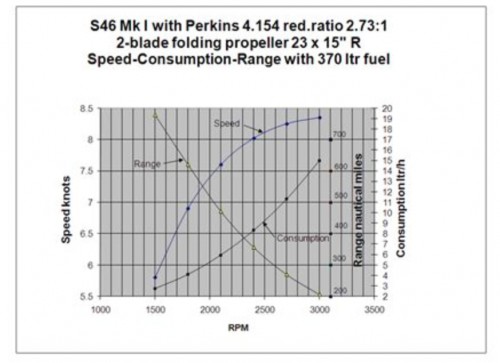Do you want to be informed on new Posts on this Thread? (members only)
| S&S Swan Maintenance - Swan 43 prop |
|---|
|
Join Date: 01 March 2007
Posts: 13 |
||
|---|---|---|
|
Swan 43 prop |
|
Join Date: 02 January 2008
Posts: 1547 |
||
|---|---|---|
|
Dear John
|
|
Join Date: 01 March 2007
Posts: 13 |
||
|---|---|---|
|
Thats the problem, 15 is too small. Unfortunately.the only way to get a larger prop in there is to move it farther back on the hull shape. Going to 17"-18'' prop would require the prop shaft strut being moved. The boat came with a folding 14" prop. I made the assumption the early 43's came with 14" props. Was I in error?
|
|
Join Date: 02 January 2008
Posts: 1547 |
||
|---|---|---|
|
Dear John
|
|
Join Date: 01 March 2007
Posts: 13 |
||
|---|---|---|
|
Lars thanks again for the suggested solution. In your opinion would a feathering 15" - 4 bladed prop have the potential be a decent/ partial solution to my small prop size dilemma? Am thinking the additional blade area provided by the fourth blade could at least partially compensate for the diameter deficiency.
|
|
Join Date: 02 January 2008
Posts: 1547 |
||
|---|---|---|
|
John
|
|
Join Date: 01 March 2007
Posts: 13 |
||
|---|---|---|
|
Thank you Lars. Will do .
|
|
Join Date: 02 January 2008
Posts: 1547 |
||
|---|---|---|
|
PS
|
|
Join Date: 11 March 2007
Posts: 11 |
||
|---|---|---|
|
Thank you Lars. Will do . john Hi John
|
|
Join Date: 01 March 2007
Posts: 13 |
||
|---|---|---|
|
Don
|
|
Join Date: 11 March 2007
Posts: 11 |
||
|---|---|---|
|
Don Thanks for your insights. The boat came with a 14" prop. I felt I was pushing my luck ( according to clearance specs.) going to 15. Moving the strut or reshaping that portion of the undersides for clearance is a big project, My prop shaft is !" diameter, is that consistent with yours? I will revisit this winter project when the boat is out of the water for a bottom job. Thanks again john John
|
|
Join Date: 02 January 2008
Posts: 1547 |
||
|---|---|---|
|
John & Don
|
|
Join Date: 11 March 2007
Posts: 11 |
||
|---|---|---|
|
John & Don Can confirm that the original Swan 43 shaft diameter is 30 mm. With a 3-blade propeller having proper diameter there is no efficiency gain going to 4 blades. Don, if you would like to have a Speed-Consumption-Range diagram made for your yacht you need to measure a number of rpm-speed combinations accurately in deep water. Say six readings distributed over the normal cruising range, one of them at full throttle. Kind regards Lars Lars
 |
|
Join Date: 02 January 2008
Posts: 1547 |
||
|---|---|---|
|
Don
|
|
Join Date: 11 March 2007
Posts: 11 |
||
|---|---|---|
|
Don Yes, your diagram would be very similar to the one shown. The diagrams delivered with the newer yachts are based on accurate measurement of rpm, speed, and fuel consumption. In your case a set of rpm/speed readings is needed, the consumption will be estimated, unless you have the possibility to measure this. The fuel tank capacity is also needed as input. If you have a calibrated speedometer it is sufficient to run at each rpm for a minute or so, enabling the speed to stabilize. If you use GPS it is usually necessary to run in two directions and use the average. When you run the full throttle lap it is recommended that you keep an eye on engine temperature. The suggestion is to use a portable rpm counter with better accuracy than the engine panel counter. The diagram is made with Excel, and can be customized for Zeevogel, including for example recommended minimum and maximum continuous rpm. Kind regards Lars Lars
|
- Threads : 1702
- Posts : 10217
- Members: 820
- Online Members: 0

